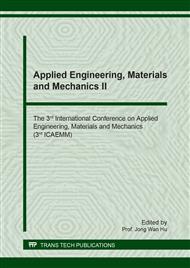[1]
H. W. Dorgarten, H. Balthaus, J. Dahl, B. Billig. Fire Resistant Tunnel Construction: Results of Fire Behavior Tests and Criteria of Application. Tunnel. Undergr. Space Tech. 19 (2004) 314.
DOI: 10.1016/j.tust.2004.01.015
Google Scholar
[2]
A. Leitner. The fire catastrophe in the Tauern Tunnel: experience and conclusions for the Austrian guidelines. Tunnel. Undergr. Space Tech. 16(l) (2001) 217-223.
DOI: 10.1016/s0886-7798(01)00042-6
Google Scholar
[3]
Y. J. Chen. Tunnel train fire case and prevention. Bei Jing: China Railway Publishing, (1997).
Google Scholar
[4]
Z. X. Wang. Preliminary investigation on highway tunnel safety. Undergr. Eng. Tunnel. (1) (2003) 2-5.
Google Scholar
[5]
S. K. Guian. Fire and Life Safety Provisions for a Long Vehicular Tunnel. Tunnel. Undergr. Space Tech. 19 (2004) 316.
DOI: 10.1016/j.tust.2004.01.017
Google Scholar
[6]
D. M. Xie, Z. Z. Qian. Experimental study on tensile strength and bond strength of concrete after high temperature. J. Zhejiang Univ. 32(5) (1998) 597-602.
Google Scholar
[7]
J. Z. Xiao, P. Wang, B. L. Zhu. Review and analysis of fire resistance of reinforced concrete materials in China. J. Build. Mater. 6(2) (2003) 182-189.
Google Scholar
[8]
T. Phan, N. J. Carino. Review of Mechanical Properties of HSC at Elevated Temperature. J. Mater. Civ. Eng. 10(1) (1998) 58-64.
DOI: 10.1061/(asce)0899-1561(1998)10:1(58)
Google Scholar
[9]
A. N. Noumowe, P. Clastres, G. Debicki, J. L. Costaz. Transient Heating Effect on High Strength Concrete. Nucl. Eng. Des. 166 (1996) 99-108.
DOI: 10.1016/0029-5493(96)01235-6
Google Scholar
[10]
Z. Y. Wang, M. C. Liao, S. J. Yu, Z. Q. Jin. High temperature performance test of Hybrid fiber reinforced concrete. J. Jiaozuo Inst. Tech. (JCR-SCI), 21(5) (2002) 338-340.
Google Scholar
[11]
I. A. EI-Arabi, H. Duddeck, H. Ahrens. Structural Analysis for Tunnels Exposed to Fire Temperatures. Tunnel. Undergr. Space Tech. 7(1) (1992) 19-24.
DOI: 10.1016/0886-7798(92)90109-u
Google Scholar
[12]
PIARC. PIARC Proposal on the Design Criteria for Resistance to Fire for Road Tunnel Structures. Paris, (2002).
Google Scholar
[13]
Z. G. Yan. Study on the fire mechanical behavior and fire resistance of tunnel lining structure. Shang Hai: Tongji university civil engineering, (2007).
Google Scholar
[14]
G. F. Zhao, S. M. Peng, C. K. Huang. Steel fiber reinforced concrete structure. Bei Jing: China building industry press, (1999).
Google Scholar
[15]
J. W. Hu, Response of Seismically Isolated Steel Frame Buildings with Sustainable Lead-Rubber Bearing (LRB) Isolator Devices Subjected to Near-Fault (NF) Ground Motions. Sustain. 7 (2015) 111-137.
DOI: 10.3390/su7010111
Google Scholar
[16]
J. W. Seo, Y. C. Kim, J. W. Hu, Pilot Study for Investigating the Cyclic Behavior of Slit Damper Systems with Recentering Shape Memory Alloy (SMA) Bending Bars Used for Seismic Restrainers, Appl. Sci. 5(3) (2015) 187-208.
DOI: 10.3390/app5030187
Google Scholar
[17]
F. J. Liu, H. H. Zhu, S. M. Liao. Application of fibrous concrete in lining of shield tunnel. Chinese J. Undergr. Space Eng. 3(1) (2007) 83-91.
Google Scholar
[18]
X. Liu, Y. Yuan, G. Ye, G. De Schutter. Mechanism of high temperature resistance of polypropylene fiber. J. Tongji Univ.(JCR-SCI). 35(7) (2007).
Google Scholar
[19]
J. Zhao, D. Y. Gao, B. Wang. Experimental study on mechanical properties of high temperature steel fiber reinforced concrete. Concrete. 11 (2006).
Google Scholar


